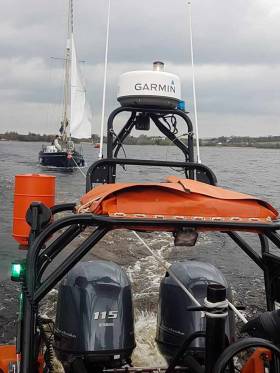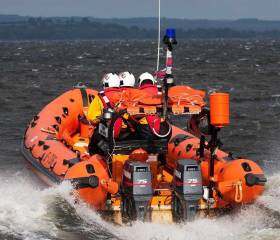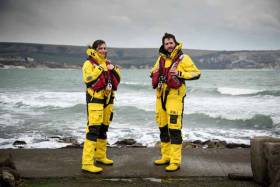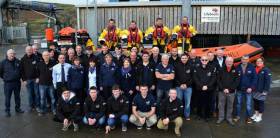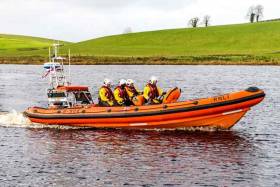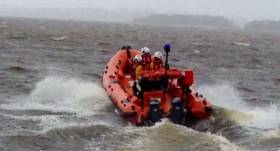Displaying items by tag: Lifeboat
At 1.20pm on Tuesday May 1, Lough Derg RNLI launched following a request by Valentia Coast Guard to assist a fisherman in an 18ft lake boat reported aground by the Goat Road on the north eastern shore of Lough Derg.
Winds were south-southeasterly, Force 4/5. Visibility was good, but with mist and frequent rain squalls.
The Lifeboat, with helm Ger Egan, Owen Cavanagh and Keith Brennan on board, arrived at the Goat Road 1.36pm, but there was no evidence of the casulty vessel. The lifeboat searched the area and located the fisherman in his boat at 'Russell Cabin', north of the Goat Road.
"An RNLI volunteer waded in to the lake boat and found the fisherman to be safe and unharmed and wearing his lifejacket"
As the lakeboat was aground in a particularly rocky and shallow area, the lifeboat dropped anchor and veered back to the location. An RNLI volunteer waded in to the lake boat and found the fisherman to be safe and unharmed and wearing his lifejacket.
The RNLI volunteer and the fisherman bailed the water taken in over the gunwales of the lakeboat. They eased the vessel off the rocks and out to to the lifeboat, where it was taken under tow to Skehana. The lakeboat was tied safely alongside at 2.56pm
The lifeboat returned to station and the lifeboat was ready for service again at 3.35pm
Liam Maloney, Volunteer Lifeboat Operations Manager advises boat users to ‘check the conditions before going afloat and make sure your vessel is able for the conditions forecast.'
Lough Derg RNLI & Killaloe Coastguard Lifeboats Assist Lone Sailor on 30ft yacht Aground in Scariff Bay
At 6.29pm on Saturday April 14, Lough Derg RNLI was requested to launch by Valentia Coast Guard to assist a lone sailor on a 30–ft yacht aground in Scariff Bay
At 6.40pm, the lifeboat launched with helm Dom Sharkey, Eleanor Hooker and Ger Egan on board. The RNLI volunteers located the vessel at 6.57pm. Winds were south-southeasterly, Force 5. Visibility was good.
Killaloe Coast Guard was also on scene and took the yacht off the sandy bank. Lough Derg RNLI volunteers stayed on scene until satisfied that all was well and no further assistance required.
The lifeboat departed the scene at 7.17pm, and was ready for service again at 7.59pm
Lifeboat helm Dom Sharkey advises boat users to ‘enjoy the lake, but make sure you check weather forecasts for Lough Derg, and to let someone know when you expect to reach harbour. Remember always to carry a means of communication, such as VHF marine radio and/or mobile phone.’
Lough Derg RNLI launched yesterday afternoon following a request from Valentia Coast Guard to assist two people after their 40ft–cruiser grounded inside the red navigation mark by Hare Island.
The lifeboat, with helm Ger Egan, Owen Cavanagh and Delia Ho on board located the vessel at 1.50pm. Winds were southeasterly, Force 5. Visibility was good.
Both passengers were found to be safe and unharmed and wearing their lifejackets.
An RNLI volunteer was transferred across to the casualty vessel where he checked that the vessel was not holed or suffered damage to its propellers or rudder.
The cruiser was taken off the rocks and continued its onward journey without further assistance from the lifeboat.
‘Enjoy the lake, but make sure you plan your trip and ensure you stay the correct side of navigation marks on the lake’
The lifeboat departed the scene at 2.11pm, and was ready for service again at 2.36pm
Lifeboat helm Ger Egan advises boat users to ‘enjoy the lake, but make sure you plan your trip and ensure you stay the correct side of navigation marks on the lake’
New Marine Clothing for RNLI, Dun Laoghaire One of Six Lifeboat Stations to Trial New Gear
The Royal National Lifeboat Institution (RNLI) and marine clothing giant Helly Hansen have today announced a new strategic partnership that will support the lifesaving charity’s aim of defeating drowning.
Helly Hansen, the global technical sailing brand founded in Norway in 1877, has committed to supporting the RNLI for the next five years through a variety of life-saving activities. These include delivering drowning prevention messages to their customers, generating income, supporting fundraising and safety campaigns, product innovation and supplying the very best kit to the RNLI’s lifesavers.
Combining almost 350 years of rich heritage, innovation and expertise at sea, the RNLI and Helly Hansen share core brand values, history and experience – making this the perfect partnership for both organisations.
Supplying the RNLI with new all-weather lifeboat crew kit, Helly Hansen has worked with the lifesaving charity to ensure the professional-grade gear will meet the demanding needs of the RNLI’s volunteer lifeboat crews. The new clothing is due to go on service from September 2018.
RNLI Chief Executive, Paul Boissier, said: ‘We are delighted to announce this partnership with Helly Hansen, a highly respected and trusted global technical apparel brand. Through this new alliance, we’ll be able to reach even more people with our vital safety messages, with Helly Hansen committed to helping us achieve our ambition of reducing drowning.
‘Helly Hansen will provide our lifesavers with the very best kit to wear when they’re saving lives at sea. Our new all-weather lifeboat kit is due to start going on service from September and our beach lifeguards will receive their new kit next year.
‘In addition to sharing our drowning prevention advice and supplying lifesaving kit, Helly Hansen has pledged to generate income, fundraise for us, provide us with preferential financial terms and make a very generous gift in kind donation, to which we are extremely grateful.’
Paul Stoneham, Chief Executive Officer, Helly Hansen, said: ‘As a brand that defines itself through its work with professionals for over 140 years, Helly Hansen has a tremendous amount of respect for the RNLI’s mission, heritage and the individuals that have built and continue to sustain this critical institution.
‘We are both proud and humbled by the serious nature of supporting those who willingly help others in their time of need, and we are motivated by the shared ambition of broadening water safety awareness and the reduction of drownings. We look forward to our work together and the continued development of a long-term partnership that we can all be proud of.’
Designed to allow greater freedom of movement, the new all-weather lifeboat kit provides better endurance levels and comfort for the charity’s crew members
Waterproof, breathable and considerably lighter than the kit it will replace, the technical layering system will ensure crew members will keep warm and dry when they’re out saving lives in all conditions. The kit comes in a wide range of sizes, with versions tailored to fit male and female crew members.
Kieran O’Connell, lifeboat mechanic at Dun Laoghaire RNLI was one of 60 crew members from six lifeboat stations across Ireland and the UK who trialled the new Helly Hansen gear. He said: ‘The new all-weather lifeboat kit is fantastic. It’s much lighter than the old kit and uses breathable fabric, which is ideal for the more demanding tasks we often need to carry out. While trialling the kit it was reassuring to find that it kept you both warm and dry, even while out at sea in harsh conditions.’
The new kit also has a version tailored for female crew members. This ensures the clothing is a better fit and is comfortable to wear for hours spent at sea.
The new kit will be rolled out to all RNLI stations with an all-weather lifeboat including the twenty-five based in Ireland.
As well as the new all-weather lifeboat crew gear and the lifeguard kit, Helly Hansen will also supply corporate clothing and uniforms for RNLI staff.
Irish Coast Guard & RNLI Issue Joint Call for Caution Around Coastal Areas & Rivers After Storm Emma
In the aftermath of storm Emma and the heavy snowfalls around the country the Irish Coast Guard and the RNLI have issued a joint call for people to exercise caution and remain vigilant around the coast and near rivers. High tides, onshore easterly winds and a sharp rise in river levels could pose a significant risk to public safety.
Although river levels have been relatively low, a quick thaw coupled with heavy rainfall could result in a surge in water levels without warning. High tides assisted by non-prevailing winds as forecasted for the East coast may result in flooding and extreme danger on exposed piers and coastlines. The public should exercise caution and stay away from piers, harbours, seawalls and riverbanks.
Up to date weather event information can be viewed on www.gov.ie
Owen Medland, RNLI Area Lifesaving Manager said, ‘ It’s been a tough few days for the country and people will want to get out and about as soon as the weather moderates. ‘Many people rescued by RNLI lifeboat crews had no intention of entering the water in the first place. All too often, people’s first instinct when they see someone in trouble in the water is to go in after them. If you see someone in danger, dial 112 and ask for the Coast Guard straight away. Look for a ring buoy or something that floats that they can hold on to and throw it out to them.’
Irish Coast Guard Search and Rescue Operations Manager Gerard O’Flynn added, “The advice of the Coast Guard is simple, Stay Back, Stay High Stay Dry. Coast Guard teams around the country have been very busy providing support to the emergency services over the past few days. Please heed the warnings and be mindful of the risk posed by a surge in river levels following the expected thaw and be mindful of the risks on exposed coastal areas”.
Crosshaven RNLI Lifeboat Rescue Casualty from Rocky Shore
Crosshaven RNLI volunteers led an inter agency rescue yesterday evening (Thursday 22 February) after being diverted from exercise to a person who had fallen on rocks at Fountainstown and was found in a serious condition by a member of the public.
The lifeboat, commanded by Aidan O’Connor with Norman Jackson, Jenna O’Shea and Georgia Keating were only a few minutes from the incident when tasked by Valentia Marine Rescue centre, and were first on scene.
Due to darkness and a rocky shore, Aidan O’Connor elected to swim in to shore with the first aid kit. Aidan continued to administer first aid until members of the Crosshaven Fire service, Crosshaven Coast Guard and an ambulance arrived. After further medical intervention, the casualty was then stretchered over the rocks to a waiting ambulance. The lifeboat returned to station at 10pm.
Lifeboat Operations Manager, Patsy Fegan, said that “The casualty was extremely lucky to have been found by a member of the public. The outcome, if he had remained there overnight would be very different. Always tell somebody where you are going and what time you will be back."
Red Bay RNLI Called Out to Walkers on Fair Head in Freezing Temperatures
Volunteer lifeboat crew with Red Bay RNLI were called out this evening (Thursday 28 December) to reports that two walkers were stranded on the Boulder Field at Fair Head, Antrim, in freezing temperatures. Red Bay RNLI located the missing walkers and illuminated the scene before the coastguard helicopter which had flown in from Scotland was able to winch them to safety.
Red Bay RNLI was requested to launch at 5.10pm when a third walker was able to get to safety and raise the alarm for the stranded walkers on Fair Head. With temperatures plummeting, Red Bay RNLI launched both their lifeboats and when on scene at Fair Head, illuminated the Boulder Field.
With the strong searchlight from the lifeboat directed onto the cliff face the two walkers were quickly identified around 150 metres up from the sea. The lifeboat guided the coastguard helicopter to the walkers and they were then winched to safety.
Commenting on the callout Red Bay RNLI Coxswain Paddy McLaughlin said, ‘we would strongly advise people to think twice about walking or hiking on difficult terrain in freezing temperatures. Every year we answer a number of callouts to walkers or hikers on Fair Head but in this weather the risks are even greater. The surface is very slippy and difficult to navigate and access to the area can be quite challenging for search and rescues crews.’
‘We are always on call to help those in trouble or difficulty and thankfully this time one of the group was able to raise the alarm.’
Union Hall RNLI to be Formally Established on a Permanent Basis
Volunteers at Union Hall RNLI are celebrating the news that their lifeboat station in West Cork is to be formally established following a successful trial.
The recommendation subject to the provision of a long term shoreworks solution was approved at a recent meeting of the RNLI Trustees.
The RNLI’s 45th lifeboat station in Ireland had been officially put on service at Union Hall in 2014 for a trial period that has lasted three years.
This followed representations that were initially made to the RNLI for a declared search and rescue asset to be established at Union Hall in February 2013.
Since then, the station has operated Maritime Nation, a B class Atlantic 75 lifeboat, from temporary station facilities, launching from a slipway adjacent to Keelbeg pier. Work will now commence towards establishing a permanent building and facilities for the station.
Since going on service, Union Hall RNLI has launched 26 times, saved one life and rescued 42 people.
The station’s lifeboat operates approximately eight miles to the west and 14 miles to the east of the greater Glandore Bay area. It is a popular spot for fishermen and visitors including anglers, rowers, swimmers and sailors. The station is flanked by Courtmacsherry RNLI to the east and Baltimore RNLI to the west.
John Kelleher, Union Hall RNLI Lifeboat Operations Manager confirmed that the station had received word from the RNLI Trustees that the trial had been a success and the station, subject to a shoreworks solution, will be made permanent.
‘We have been waiting for this news and to finally get confirmation that the trial has been a success is great - I am delighted not just for our volunteer crew and station management but for everyone who has been involved and supported the setting up of a station here in the locality.
‘I would like to commend the commitment and dedication of our volunteer crew members who have devoted their time to training and to learning and developing new skills to help them save lives at sea. It is thanks to their efforts and those working so hard on the shore - be it to prepare the lifeboat to go to sea or washing it down after a call out, or to educate people about the dangers of water, or to fundraise - that we are now able to provide this service permanently to the community in West Cork and to anyone who may find themselves in distress at sea.’
Paddy O’Donovan, Union Hall Chairman added: ‘I was delighted with the news, it is a vote of confidence in our local volunteers. We wish to thank all the RNLI personnel who visited and helped in this project. We look forward to the next phase in making the station permanent.’
New Carrybridge RNLI Lifeboat on Lough Erne
A new Atlantic 85 class lifeboat has gone on service at Carrybridge RNLI. The lifeboat which arrived at the Upper Lough Erne lifeboat station on Tuesday (7 November), replaces Duckhams 2001, which has been used to rescue people on Lough Erne in County Fermanagh since 2015.
Volunteer lifeboat crew began a period of familiarisation training on Tuesday afternoon with their first exercise on the Douglas, Euan and Kay Richards.
The new lifeboat has been funded by The John and Elizabeth Allan Memorial Trust. Professor James Allan’s interest in the RNLI began as a child when he went to Fraserburgh in Scotland, on holiday with his family. Along with his sister Elizabeth, he met the volunteer lifeboat crew and on returning a year later, Professor Allan was delighted that the crew remembered them.
The new lifeboat for Carrybridge is to be named Douglas, Euan and Kay Richards after the children of Professor Allan’s doctor. The lifeboat will be officially named at a special naming ceremony and service of dedication at Carrybridge RNLI’s lifeboat station next year. Carrybridge RNLI also has a Rescue Water Craft.
During her time at Carrybridge, Duckhams 2001 launched 64 times, with its volunteer lifeboat crew rescuing 113 people.
The new lifeboat has some advancement on its predecessor. The Atlantic 85 design allows room for four crew members and more kit than the Atlantic 75 lifeboat, which only had room for three crew members.
The lifeboat is powered by two 115 horse power engines and has a stronger hull and greater top speed of 35 knots. The added radar allows the crew to operate more effectively in poor visibility and there is also VHF direction-finding equipment.
The vessel also has a manually operated self-righting mechanism which combined with inversion-proofed engines keeps the lifeboat operational even after capsize. The lifeboat can also be beached in an emergency without causing damage to its engines or steering gear.
The Atlantic 85 which was introduced to the RNLI fleet in 2005 also carries a full suite of communication and electronic navigation aids, as well as a searchlight, night-vision equipment and flares for night-time operations.
Speaking following the arrival of the new lifeboat, Tom Bailey, Carrybridge RNLI Lifeboat Operations Manager said: ‘We are extremely grateful to Professor James Allan for his generous donation which has funded our new lifeboat. As we welcome a new lifeboat, there is also a sense of nostalgia too as we bid a fond farewell to Duckhams 2001, a lifeboat that provided us with almost three great years of service. Her time here in Fermanagh brought many people safely to shore and we hope her donor family will be just as proud as we are, of her many achievements.
‘We are looking forward to being the custodians of this new lifeboat which will allow our volunteers to go on to rescue and save many more lives in the years to come.’
The RNLI is a charity which relies on voluntary contributions and legacies.
RNLI On Lough Derg Respond to Vessel Reported To Be On Fire
At 2.34pm, Monday October 30, Lough Derg RNLI lifeboat launched following a request from Valentia Coast Guard to assist two people and a dog on boat a vessel reported to be on fire. The wind was south-westerly, F1 and with good visibility.
The lifeboat located the 31ft cruiser at anchor off Hare Island off the County Clare shore, the passengers and their dog were safe and unharmed. The skipper had cut his engine and dropped anchor when he noticed black smoke billowing from the engine. When the lifeboat arrived on scene, the engine was no longer issuing smoke and the situation had settled.
With an RNLI crew member on board, the cruiser with her passengers was taken under tow for the public harbour at Dromineer. As the lifeboat was towing the cruiser, volunteer crew were informed that the dog had jumped overboard. The lifeboat immediately stopped its engine and made to recover the dog from the water. However, with encouragement from his owners, the dog swam back to the casualty vessel where he was brought back on board.
After the cruiser was safely tied up alongside in Dromineer Harbour, the lifeboat returned to station and was ready for service at 5pm.
At 12.23pm on Sunday, October 29, Lough Derg RNLI Lifeboat launched following a request from Valentia Coast Guard to assist 5 people on board a 40ft cruiser aground behind Illaunmore on the north eastern shore of Lough Derg. Winds were south-westerly and F1.
The lifeboat located the vessel at 12.47pm and found all passengers to be safe and unharmed and wearing their lifejackets. The lifeboat transferred an RNLI volunteer across to the cruiser, where he inspected the boat, and once satisfied that it was not holed he prepared the boat to be taken off the rocks. However when the casualty vessel was found to be stuck fast on the rocks, the lifeboat crew decided to take the five passengers and their belongings to Dromineer. Meanwhile RNLI volunteer shore crew made arrangements to have the boat lifted off the rocks.
The lifeboat was ready for service again at 2.35pm
Pat Garland, Deputy Launching Authority at Lough Derg RNLI Lifeboat Station, advises boat users to ‘enjoy the lake, but make sure you stay on the navigation route, well clear of the shoreline’.



























